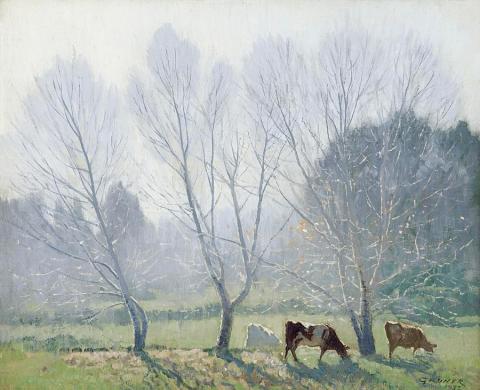FROSTY MORNING, 1932
ELIOTH GRUNER
oil on canvas on board
36.0 x 44.0 cm
signed and dated lower right: GRUNER / 1932
Mrs Saul Symonds, Sydney
Dr Roseby, Melbourne
Thence by descent
Private collection, Melbourne
National Art Gallery of New South Wales, Sydney, 17 April – 30 May 1940, and National Gallery of Victoria, Melbourne, 5 July – 4 August, 1940, cat. 17
Art in Australia, 3rd Series, no. 50, June 1933, Elioth Gruner Oil Paintings, p. 21 (illus., as 'Frosts, 1932')
The early morning mist rising from the ground warmed by the ascending sun is suspended for a few magical moments before disappearing in the light of day. Elioth Gruner is the unrivalled master of mists and morning light, Frosty Morning 1932 being a classic example. Such transient effects are central to his art, as also the view looking into the light, which saturates the painting. The sun likewise warms the nakedness of the trees in winter undress, a metaphor of the season of regeneration. Cows graze peacefully in a stillness that is palpable, aesthetic appeal heightened by compositional finesse and captivating colour, all enveloped in the gentle, harmonising atmosphere. The disarming appeal of the mauves and blues of his shadows unnerved some of his influential contemporaries. The acquisition of one of his most popular paintings, Spring Frost 1919, which was awarded the Wynne Prize for that year, was opposed by W. Lister Lister, then Vice-President of the Trustees of the Art Gallery of New South Wales because "'the shadows were too blue''. Moreover, Bernard Hall, Director of the National Gallery of Victoria, 'exclaimed to Gruner that he would never see those colours,' to which the artist replied 'you would if you got up early enough'.1 The media hailed the painting 'as the picture of the year'.2 It was eventually acquired by the Gallery in 1939 as a gift.
Paintings on the theme of morning light in all the sparkling freshness of spring or crispness of autumn are found throughout his oeuvre. His widely recognised masterpiece Morning Light, in the collection of the Art Gallery of New South Wales, won the 1916 Wynne Prize for landscape painting. Others are in major Australian public collections, particularly fine examples being Spring Morning 1917 in the Newcastle Art Gallery, and Clearing Mists 1918 in the Art Gallery of South Australia. Clearing Fog, Prospect 1917 and Morning Mists c1920, are both in the Queensland Art Gallery. In 1935, Spring at Bathurst c1934-35 was acquired by the National Gallery of Victoria, Melbourne, through the Felton Bequest. In the year of our painting, spring and mists had an even greater appeal for Gruner, as seen in two works exhibited in his 1983 retrospective arranged by the Art Gallery of New South Wales - Dissolving Mists 1932 (private collection), and Spring in the Orchard c1932.3 Like these works Frosty Morning 1932 is painted with that attention to perfection, which characterises the best of his art. It is a superb example of Gruner's mastery of the vibrant, light filled landscape, of images soft in silhouette within a field of poetic reverie and love of paint.
1. Quoted in Pearce, B., Elioth Gruner 1882-1939, Art Gallery of New South Wales, Sydney, 1983, p. 39
2. Ibid.
3. Dissolving Mists 1932 and Spring in the Orchard c1932, Pearce, 1983, op. cit., cats 62 and 65 respectively
DAVID THOMAS
